Intelligent, obedient, faithful, energetic and punitive. Fulfilling every order and command, and in addition ready to both take the life of the enemy and give his own in the defense of the man with whom he serves. Here is the recipe for the perfect USSR-era service dog.
Few people who are not related to the military, service dog training and border guards have heard of Nikita Karacupa. He was born, according to official reports from the Soviet press, on April 25, 1910 to a peasant family from the village of Alekseevka (now a city in the southwestern part of Russia, in the Belgorod region). He lost his father early, and his mother, with him and his siblings, moved to Atbasar - a city now located in northern Kazakhstan, an industrial and agricultural center.
Soon the mother also died, and Nikita ended up in an orphanage to which he could not adapt, so he ran away at the first opportunity. He earned his living by grazing cattle and sheep. He self-trained a herding dog to help protect the herd from wolves.
Born Stalker
As soon as the enlistment option arose in 1932, Karacupa knew he wanted to serve on the border. He was laughed at at the registration and recruiting office due to his short stature . The resolute boy explained to the commissioner that this was not a fault, but an advantage:his height would allow him to camouflage himself more easily, sneak around and remain unnoticed by the enemy.
Thus, Nikita ended up in military training, and then on the Manchurian border, then extremely restless. The experience from years of shepherding quickly turned out to be an advantage - he was a great tracker, flawlessly reading human and animal tracks, perfectly coping with difficult terrain, and he understood the dog without words.
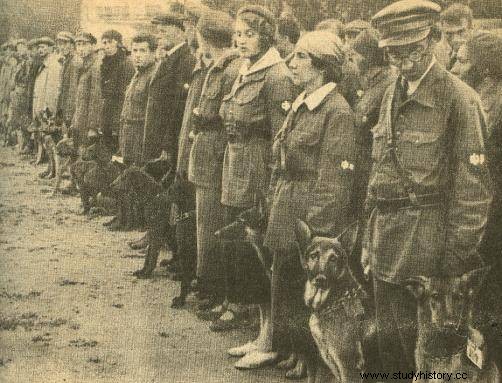
Soviet dog training school
After graduating from the District Dog Breeding School of the Border and Internal Guard in 1933 (1933), he was sent to training for the commanding staff at the Central School of Service Dog Breeding of the Border and Internal Guard of the NKVD (1937). He also completed retraining courses for the command staff of the Central School of Service Dog Breeding of the NKVD Army (1939).
Material for a service dog
Meanwhile, the very first days at the district school questioned his further career, when the young cadet was late to start training in service dogs, and therefore was not awarded, like the rest of the cadets, a purebred puppy . During an afternoon walk, by chance, he managed to find two abandoned dogs - mongrel Caucasian Shepherds, which he had adopted. He described it in his memoirs:
Strange noises were coming from under the bridge. I carefully descended the slope to the water itself. Something moved. I looked closely and saw two puppies. I took them in my arms. The little ones squealed pitifully and poked me on the cheek. They trembled with the evening dampness. I unbuttoned my shirt, tucked it behind her, and headed to school. I told the chef about the puppies in a great secret. We fed them, wrapped them in a blanket and fell asleep.
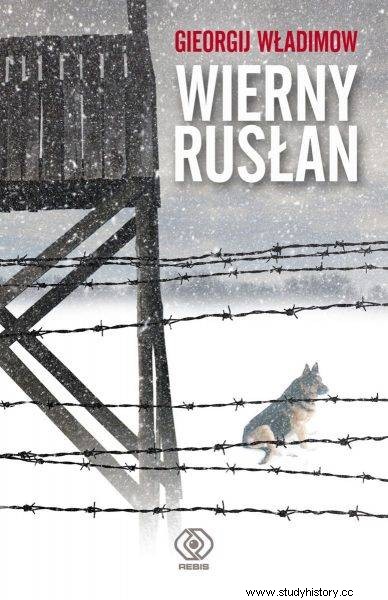
The text was inspired by the novel by Gierogij Władimov "Wierny Ruslan", which has just been published by the Rebis publishing house.
The dogs looked like two drops of water, but after a month Nikita began to notice that one of the puppies was more intelligent and energetic. He saw material for a service dog in it, just like Mr. Ruslana - the four-legged hero of the book Faithful Ruslan by Georgy Vladimov, when he chose a puppy for service in the gulag:
Pan crouched down, looked for a long time, then held out his hand. And then five brothers and sisters of Ruslan ran towards that hand with humility, a mournful whimper, trembling with fear and impatience - and the proud mother, cheering up, gently nudged them with her nose. And only he, Ruslan, bristled and, snarling, crawled away into the dark corner of the playpen . […] And the hand missed all five, reached for him and, taking the skin of the neck, lifted it up to the light.
A menacing face - the one he will idolize and then hate - approached and smiled, and he, full of anger and fear, roared and curled up, waving his paws and tail . […] Wary, carcass. This one will serve you. Look how angry he is. […] Let him feed a little more. And the top ones.
A mongrel from under the bridge on a soldier's Wikt
Meanwhile, Nikita had a huge problem - what to do with an unexpected find. The cook decided to put the animals in a warehouse, where the young cadet would visit the pooches whenever he had free time. One day a catastrophe happened - the director entered the warehouse and discovered in a box he found two puppies. An argument broke out and Karacupa was asked to explain:
Comrade principal of the school - I turned to the officer - leave at least one - here I pointed to mine. - Look at his ears. The Indian pricked his ears when he heard his name, then looked first at the officer, then at me. […]
The director was a strict but kind man. [...] He agreed that I should keep the puppy - he ordered him to be moved to a box and enlisted for service. This meant that would get his right:meat and grain with which to cook him food. He took the second puppy for his own son.
That day I was the happiest person in the world:my dream came true. I also had my dog. I happily kissed the Indian and he licked my face. I made no mistake in choosing:the Indian served me faithfully for many years, helped me many times and saved my life! Together we were freezing in the cold, hunting down criminals, together we got wet in the pouring rain, we were exhausted by the heat.
A Dog's Life
What could the Indian training course have been like, making him the perfect companion in his dangerous frontier service? Let's go back to Ruslan's story:
In his youth Ruslan went through all the teachings for which a dog is made. At first it was general training, with everyone:"Sit", "Lie down", "To me". After that, the dog performed excellently in tracking and in guard duty. […]
In a real convoy, where only one command is given:"Watch!" and then you have to figure it out and orient yourself in the situation. And it is not a warehouse that will not escape anywhere and does not arouse any special feelings, but the most precious and complicated things - people. You should always fear them and feel no pity for them, and even better - and anger, healthy suspicion is enough.
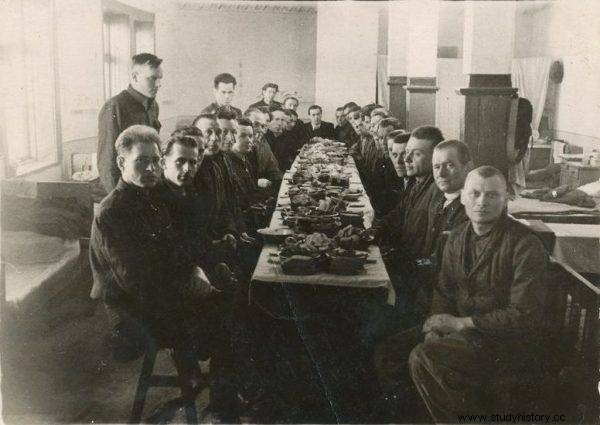
A gulag prisoner received 60 grams of meat a day. For comparison:camp guard dogs gained almost half a kilo
The dogs on duty - whether in border guards or in a labor camp - were treated almost as well as humans. Unless we're talking about prisoners - they could only dream of a "doggy life". As reported by Anne Applebaum in Gulag :“His [prisoner - ABR's] daily food allowance was 2,400 kilocalories and consisted of:less than 800 grams of bread, half a kilogram of vegetables (usually rotten), 100 grams of cod (most often spoiled) and 60 grams of meat. For comparison: the camp guard dogs received almost half a kilogram of meat a day ”.
Capture but don't bite
The young guard successfully passed the exams and, together with his dog, was sent to the "Połtawka" facility (currently crossing the Russian-Chinese border). Service in this area was extremely difficult and dangerous - smugglers and reconnaissance or subversive groups broke through the border, consisting of people well-trained in hand-to-hand combat or shooting techniques, who were able to cope with difficult terrain and avoid pursuit by blurring their tracks.
In the first three years after Nikita Fedorovich arrived in Poltava, the border services detained over 130 people at the border. The transport to Soviet Russia of contraband worth 600,000 zlotys was foiled. rubles (mainly alcohol and opium) , and Karacupa himself - according to his own calculations - spent over 5,000 hours on duty, defeating 16,000 in murderous chases. kilometers. An Indian accompanied him at almost every action.
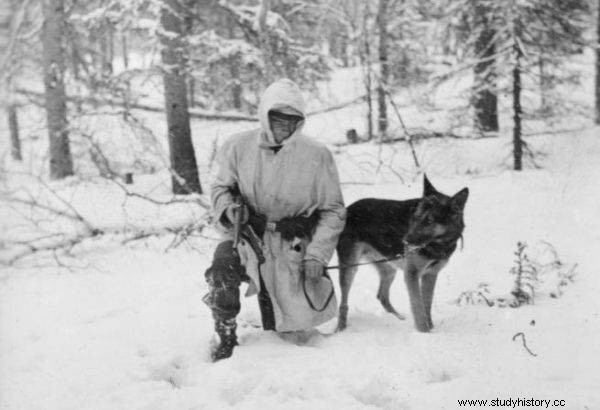
Dogs helped, among others when patrolling the borders (illustrative photo)
Comrades-in-arms said that Nikita and his dog could chase the enemy thirty or even fifty kilometers, leaving the rest of the border guards far behind. Sam engaged in combat with several armed attackers. A case was described in which Karacupa along with an Indian, after a long chase, captured, disarmed and arrested a group of 9 armed drug couriers. Thanks to a well-trained Indian who prevented one of the couriers from reaching for a hidden weapon, the guard escaped with his life. The dog reacted as trained - to overpower but not kill. Exactly like Ruslan:
A roar and a howl escaped from Ruslan's mouth ; he drooled and looked at his lord imploringly, pleading for the longed-for command:"Take him" . It will certainly sound soon; already your face turned white, your teeth clenched, a moment longer and you can hear an explosion - as if not from your mouth, but from your hand thrown out to the front - of the words:"Ruslan, take him!"
And then the real Service will begin - in ecstasy of subordination, in a frenetic, fierce rush, with sideways jumps to confuse an enemy who will start thrashing, not knowing if he has to defend or to run away. And there will be one last jump, paws on the chest, and the enemy will be knocked down, and Ruslan will fall with him, roaring straight into his face contorted with terror, but he will only grab his hand, only his right hand ...
Aleksander Solzhenitsyn in the Gulag Archipelago wrote that the camp dogs "[...] depending on the order - know how to strangle a person, they can bite, and they can also only tear clothes, undressing the victim naked ". Border guard dogs were also trained to arrest a prisoner and bring him to the facility in a condition that would allow for interrogation. This was especially true of spies, who often carried poison capsules with them to be taken in case of capture.
Hero of the nation
The phenomenal skills of Nikita Fedorovich and his dog quickly reached the ears of journalists. When the correspondent of Yevgeny Ryabchikov sent to the border with Komsomolskaya Pravda published a series of articles devoted to the guard and his four-legged companion, they gained immense popularity in the country. "I saw Nikita Karacupa travel tens of kilometers, shoot at a gallop, move noiselessly . Everything he did, he did in silence, in a confident and controlled manner, and at the same time with such simplicity and modesty, as if he did not feel a mortal threat, "wrote Ryabchikov.
Karacupa's merits and his almost superhuman abilities made him an idol for both civilians and young soldiers, who saw him as a nation's hero. Karacupa, for example, was able to distinguish more than 240 kinds of smells, which was an invaluable skill for a border guard.
He described in his autobiography a case where he had to go to action without an Indian recovering from a gunshot and he unmistakably identified the smell of PVC insulated wires that the two spies had tried to put under the cover of night on telegraph poles.
"Stories about the legendary Nikita Karacupa and his Ingus who stopped some 400 enemies at the border also reached our ears. Could a young boy, a soldier, pass by such stories indifferently? " - asked rhetorically in his memoirs Col. Oleg Iwanowski, counterintelligence officer and chief designer of the first Vostok, who served on the border in 1940.
Faithful Service
In 1944, when the USSR regained control over the territory of Belarus, Karacupa was sent to restore the border service and fight the enemy survivors hiding in the forests and Nazi collaborators. He spent 13 years there, after which he was delegated to North Vietnam by order of the commander of border troops.
Again, his task was to organize the border service, this time in a distant and exotic country. He performed it perfectly. In 1961, with the rank of colonel, Karacupa was placed in the reserve. He had 338 arrests, 129 killed enemies and participated in 120 armed clashes as well as decorations:the Order of Lenin, two Orders of the Red Banner, the Red Star and many others. Four years later, in June 1965, he was awarded the title of Hero of the Soviet Union.

The text was inspired by the novel by Gierogij Władimov "Wierny Ruslan", which has just been published by the Rebis publishing house.
As a civilian, Karacupa started working at the Pulsar Research Institute in Moscow and at the Central Museum of Border Guard. He died on November 18, 1994. His name is still used today by Russian schools and libraries, but also by border posts in Russia, Vietnam and India. They are also worn by the police station in Połtawka, where the statue of Nikita and the first of his faithful companions, who had a special place in the heart of the young guard, still stands.
Honor salvo for the dog
Nikita Fyodorovich recalled that when the first Indian died on duty, he placed the very date of birth on a plate above his own bayonet, in the belief that "The Indian did not die for me, he will live in my heart forever" . The unusual bond that the guard established with the dog raised and trained from a puppy is described in the book Faithful Ruslan :
The second half of Ruslan's life was already on the way, and during the first half of Ruslan's life the dog got used to being always with people, serving them, listening to them and loving them. [...] Ruslan was forever poisoned by his love and agreement with the human world like a sweet poison that kills the alcoholic more than alcohol itself, and the greatest pleasure of hunting could no longer replace him with another pleasure:obedience to his beloved man, happiness brought about by one of his words of praise .
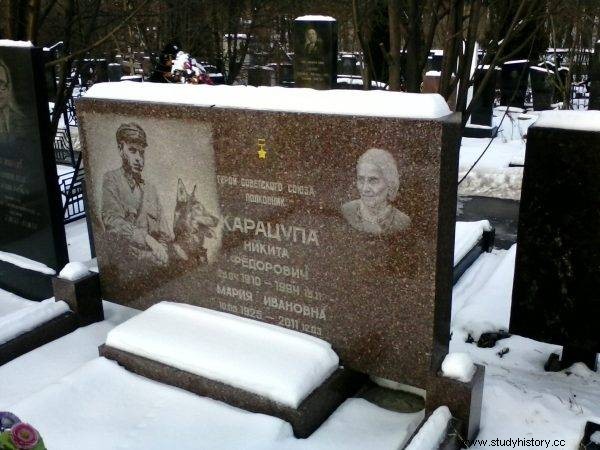
The tomb of Nikita Karacupa
Karacupa treated his dogs as friends and comrades-in-arms - after burying the first of them, the Indian who died during the action, fired a volley of honor over his grave. Suddenly he heard more shots - it turned out that other guards had come to honor the heroic death of the four-legged guard . All subsequent Karacupa dogs bore the same name, and the last Indian, seriously wounded on duty, came with him to Moscow, where Karacupa settled after his military career ended. Unfortunately, it was not possible to save him. Interestingly, when the Soviet Union established peaceful relations with independent India in the 1950s, by the decision of the Comintern, the names 'Ingus' began to be written in official publications.
In addition to his official duties, Karacupa spent a great deal of time writing down his experiences, which he considered valuable training material. He conducted research on the intelligence of dogs, developed special training manuals for young officers, the theory and methodology of which are still largely relevant today. He used his vast knowledge and experience until the end of his life.
“Karacupa's biography has inspired many future border guards to join the service, and he has trained thousands of rangers and dog handlers. His experience of breeding dogs for border guard service is still being used. He became a legend of border guards while he was still alive and this legend is still alive "- summed up Alexander Mikhailov, a historian from the Victory Museum.
Inspiration:
The text was inspired by the novel by Gierogii Władimov "Wierny Ruslan", which has just been published by the Rebis publishing house.
